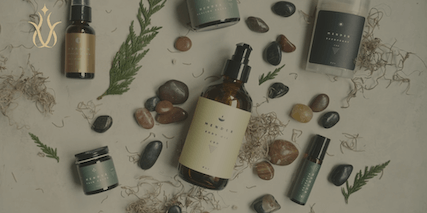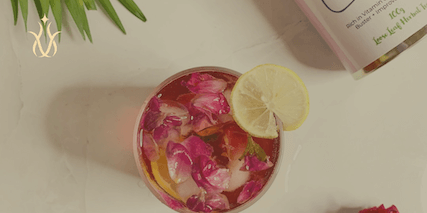Dive into the aromatic world of essential oils with our comprehensive guide. Essential oils are not just fragrant; they possess powerful therapeutic properties that can improve your physical, mental, and emotional health. This guide covers everything from the basics of what essential oils are, to detailed profiles on the most popular oils like lavender, peppermint, and tea tree. Learn how to safely use essential oils for aromatherapy, skincare, household cleaning, and even pest control. We also include expert tips on blending oils, dilution rates, and the best practices for storage.
Whether you’re a beginner or an experienced user, discover how to effectively integrate essential oils into your daily routine for a healthier, more balanced lifestyle.
What is an Essential Oil?
An essential oil is a highly concentrated, aromatic liquid derived from plants. It is typically extracted through various methods, such as steam distillation or cold pressing, to capture the natural compounds found in the plant material. Essential oils contain the characteristic fragrance and beneficial properties of the plant they are derived from.
These oils are called “essential” because they contain the “essence” of the plant, including its aroma and potential therapeutic properties. They are highly concentrated and potent, as they are extracted from large amounts of plant material. Essential oils are used in aromatherapy, a practice that harnesses the aromatic and therapeutic properties of plants for physical, emotional, and psychological well-being.
Essential oils are composed of various chemical compounds, including terpenes, alcohols, esters, ketones, and phenols, among others. Each essential oil has a unique chemical composition, giving it distinct characteristics and potential benefits. They can be used for relaxation, mood enhancement, skincare, hair care, cleaning, and more.
How Do you Make Essential Oils?
Essential oils are made through a process called distillation, which involves extracting the aromatic compounds from plant materials. The most common method of distillation is steam distillation, although there are other techniques like cold pressing and solvent extraction used for specific plant materials.
Here is a simplified overview of the steam distillation process:
Harvesting: The plant material, such as leaves, flowers, or stems, is harvested at the optimal time to ensure the highest concentration of aromatic compounds.
Distillation Apparatus: The plant material is placed in a distillation apparatus, which typically consists of a still or a distillation flask, a condenser, and a collection vessel.
Steam Injection: Steam is injected into the distillation apparatus. The heat from the steam causes the plant material to release its aromatic compounds.
Vaporisation and Condensation: As the plant material is heated, the volatile aromatic compounds turn into vapour. The vapour then rises through the distillation apparatus and enters the condenser.
Cooling: In the condenser, the vapour is cooled, causing it to condense back into a liquid state.
Separation: The condensed liquid, which consists of water and essential oil, is collected in the collection vessel. As essential oils are lighter than water, they float on top and can be easily separated.
Filtration: The collected liquid may undergo filtration to remove any impurities or plant residues.
Storage: The resulting liquid is the essential oil, which is highly concentrated and fragrant. It is stored in dark, airtight bottles to protect it from light and heat, preserving its quality and potency.
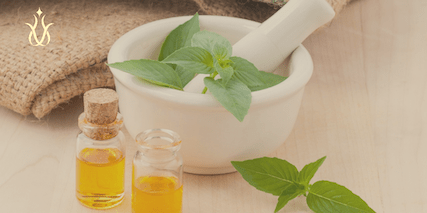
How Can You Make Essential Oils at Home?
While it’s challenging to produce essential oils at home with the same level of quality and concentration as commercially available ones, you can create infused oils or aromatic extracts using a simple home method. Here’s a basic process for making infused oils:
Choose your base oil: Start by selecting a carrier oil, such as olive oil, jojoba oil, or almond oil. These oils will act as the base for your infused oil.
Select your plant material: Decide on the plant material you want to use for infusion. This can be dried herbs, flowers, or citrus peels. Ensure that your chosen plant material is clean and free from pesticides or chemicals.
Prepare the plant material: If using fresh herbs or flowers, allow them to wilt for a few hours to remove excess moisture. If using dried plant material, crush or chop it to increase its surface area.
Combine the oil and plant material: Place the plant material in a clean glass jar and cover it with the carrier oil. Ensure that the plant material is completely submerged in the oil.
Infusion process: Seal the jar tightly and place it in a warm spot, such as a sunny windowsill, for a few weeks. This allows the oil to extract the aromatic compounds from the plant material. Shake the jar gently every few days to aid the infusion process.
Straining: After the infusion period, strain the oil through a cheesecloth or fine-mesh sieve to remove the plant material. Squeeze the cloth or press the material to extract as much oil as possible.
Storage: Transfer the infused oil into a clean, dark glass bottle with a tight-fitting lid. Store it in a cool, dark place away from direct sunlight to maintain its quality.
It’s important to note that homemade infused oils may not have the same potency or concentration as commercially produced oils. They are more suitable for culinary or mild aromatic purposes rather than therapeutic uses. Additionally, it’s crucial to use proper hygiene practices and ensure the plant material is safe for infusion before attempting this process at home.
What are Essential Oils Used for?
Essential oils are used for various purposes due to their aromatic and therapeutic properties. Some common uses include:
Aromatherapy: Essential oils are widely used in aromatherapy to promote relaxation, reduce stress, uplift mood, and improve overall well-being. Inhalation of the aromatic compounds can have a direct impact on the limbic system, which is involved in emotions and memory.
Skin and Hair Care: Many essential oils are used in skincare and haircare products due to their potential benefits for the skin and hair. They can be found in moisturisers, serums, shampoos, and conditioners. Examples include lavender oil for soothing the skin, tea tree oil for its antimicrobial properties, and rosemary oil for stimulating hair growth.
Natural Home Cleaning: Some essential oils possess antimicrobial properties that make them effective in natural cleaning solutions. For example, tea tree oil is known for its antibacterial and anti-fungal properties and can be added to homemade cleaning products.
Relaxation and Sleep: Certain essential oils, such as lavender, chamomile, and bergamot, are known for their calming properties and are often used to promote relaxation and improve sleep quality. They can be used in diffusers, applied topically (properly diluted), or added to bathwater.
Pain Relief: Some essential oils, such as peppermint and eucalyptus, have analgesic properties and can be used topically to help alleviate muscle or joint pain. They are often found in massage oils or used in compresses.
Natural Insect Repellent: Certain essential oils, such as citronella, lemongrass, and peppermint, have insect-repellent properties and can be used as a natural alternative to chemical-based repellents.
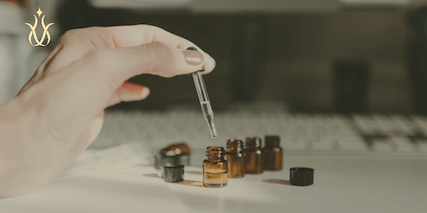
Do Essential Oils Work?
Yes, essential oils have been found to have various beneficial effects and can work effectively for certain purposes. However, it’s important to note that the effectiveness can vary depending on the individual, the specific condition being addressed, and the quality and purity of the oil itself.
Here are some ways in which essential oils have been found to work:
Aromatherapy: Essential oils have been used for centuries in aromatherapy to promote relaxation, reduce stress, improve mood, and support overall well-being. The inhalation of essential oil vapours can stimulate the olfactory system and have a direct impact on the brain, influencing emotions and promoting a sense of calm.
Skin Care: Many essential oils possess properties that can benefit the skin. For example, tea tree oil has antimicrobial properties and can be effective against acne-causing bacteria. Lavender oil is known for its soothing and calming properties and is often used in skincare products for its potential to reduce inflammation and promote healing.
Natural Remedies: Certain essential oils, when used appropriately, may offer natural remedies for common ailments. For example, peppermint oil has been shown to help alleviate headaches, and ginger oil may help reduce nausea.
However, it’s important to note that they should not replace medical advice or treatment, and their use should be complementary to standard medical care.
Massage and Relaxation: Essential oils are often used in massage therapy to enhance relaxation and provide a sensory experience. When combined with carrier oils and applied to the skin, essential oils can penetrate the tissues and muscles, offering a soothing and therapeutic effect.
It’s important to use essential oils safely and responsibly. Ensure that you are using pure, high-quality oils, properly diluting them, and following recommended guidelines for usage. It’s also essential to consider any individual sensitivities or allergies and to consult with a qualified aromatherapist or healthcare professional if you have specific health concerns or questions.
How Do You Use Essential Oils?
Essential oils can be used in various ways to enjoy their aromatic properties and potential therapeutic benefits. Here are some common methods of using essential oils:
Aromatherapy Diffusion: Use an essential oil diffuser or aromatherapy diffuser to disperse the oil into the air. This method allows you to inhale the scent and experience its aromatherapeutic effects. Follow the manufacturer’s instructions for your specific diffuser.
Inhalation: Add a few drops of essential oil to a tissue, cotton ball, or inhaler and breathe in the aroma directly. This method is beneficial for respiratory conditions or to promote relaxation and mood enhancement.
Topical Application: Dilute essential oils with a carrier oil (such as coconut oil or almond oil) before applying them to the skin. This is important to prevent skin irritation, as essential oils are highly concentrated. Apply the diluted oil to areas of concern, such as joints or muscles, or for skincare purposes. Perform a patch test before applying to a larger area.
Massage: Incorporate essential oils into a massage by adding a few drops to a carrier oil. The combination of massage and essential oils can promote relaxation, relieve muscle tension, and enhance overall well-being.
Bathing: Add a few drops of essential oil to a warm bath for a soothing and aromatic experience. Ensure the oil is properly dispersed by mixing it with a carrier oil, bath salts, or an emulsifier like honey or milk before adding it to the bathwater.
Compress: Add a few drops of essential oil to a bowl of warm or cold water. Soak a clean cloth in the mixture, wring out excess liquid, and apply the compress to the desired area. This method can be helpful for localised pain or inflammation.
Remember to use essential oils mindfully, follow proper dilution guidelines, and consult a qualified aromatherapist or healthcare professional if you have any specific health concerns or conditions. It’s also essential to research each essential oil’s safety precautions, as some oils may have contraindications for certain individuals, such as pregnant women, infants, or people with certain medical conditions.
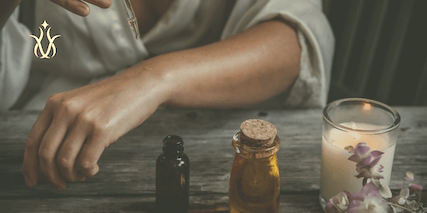
Are Essential Oils Safe?
Essential oils can be safe when used properly and with caution. However, it’s important to understand they are highly concentrated substances and should be handled with care. Here are some guidelines to ensure safe use of essential oils:
Dilution: Most essential oils should be diluted with a carrier oil, such as coconut or jojoba oil before applying them to the skin. This helps to prevent skin irritation or sensitisation. The recommended dilution ratio is typically around 2-5% essential oil to carrier oil, depending on the specific oil and intended use. Always follow the recommended dilution guidelines for each essential oil.
Patch Test: Before using a new essential oil topically, perform a patch test on a small area of skin to check for any adverse reactions or sensitivities. Apply a diluted drop of the essential oil to the inside of your forearm and observe for at least 24 hours. If any redness, itching, or irritation occurs, discontinue use.
Inhalation Safety: When using essential oils for inhalation, it’s important to use a diffuser or vaporiser according to the manufacturer’s instructions. Avoid direct inhalation or excessive exposure to the oil’s vapours, as this can cause respiratory irritation. Keep the room well-ventilated.
Avoiding Sensitive Areas: Some essential oils, such as peppermint or cinnamon, can be irritating to sensitive areas like the eyes, mucous membranes, or broken skin. Exercise caution when applying oils near these areas and avoid internal ingestion of essential oils unless under the guidance of a qualified professional.
Pregnancy and Children: Certain oils may not be safe for use during pregnancy or for young children. Consult with a healthcare professional or aromatherapist before using essential oils if you are pregnant, nursing, or have children.
Quality and Purity: Choose high-quality, pure essential oils from reputable sources. Look for oils that are labelled as “100% pure” or “therapeutic grade” and have undergone third-party testing for quality and purity.
It’s important to note that some individuals may have specific allergies, sensitivities, or medical conditions that make them more prone to adverse reactions to essential oils. If you have any concerns or questions, consult with a healthcare professional or a qualified aromatherapist.
How Do You Use Essential Oils in a Diffuser?
Using essential oils in a diffuser is a popular method for enjoying their aromatherapy benefits. Here’s how you can use essential oils in a diffuser:
Choose a diffuser: There are various types of diffusers available, such as ultrasonic diffusers, nebulising diffusers, and heat diffusers. Follow the instructions specific to your diffuser model.
Fill the diffuser with water: Most diffusers have a water reservoir. Fill it with clean, room-temperature water. Be sure not to exceed the maximum water level indicated by the manufacturer.
Add essential oils: Add a few drops of your chosen oil or a blend of oils to the water in the diffuser. The number of drops will depend on the size of the diffuser and your personal preference. Start with 3-5 drops and adjust as needed.
Optional: Some diffusers may have additional features like timers or settings for controlling the intensity of the mist. Adjust these settings according to your preference.
Turn on the diffuser: Plug in the diffuser and turn it on following the instructions provided. The diffuser will start releasing a fine mist of water and essential oil particles into the air.
Enjoy the aroma: Allow the diffuser to run for the desired duration, typically 1-3 hours. As the oils disperse into the air, they will create a pleasant and aromatic environment. Sit back, relax, and enjoy the aroma.
Safety Tips:
Use only pure, high-quality essential oils in your diffuser.
Follow the manufacturer’s instructions for your specific diffuser model.
Keep the diffuser out of reach of children and pets.
Place the diffuser on a stable surface away from electronics or water-sensitive items.
Clean your diffuser regularly to prevent buildup and maintain optimal performance.
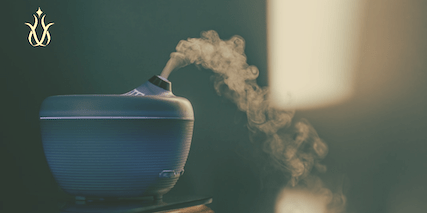
Is Diffusing Essential Oils Safe for Your Lungs?
Diffusing essential oils can be safe for your lungs when used properly. However, it’s important to follow some guidelines to ensure safety:
Quality of essential oils: Choose high-quality, pure essential oils from reputable brands. Poor quality or adulterated oils may contain impurities that can be harmful when inhaled.
Dilution: When using essential oils in a diffuser, they are typically dispersed in the air in small amounts, which makes them less concentrated compared to direct inhalation or topical application. This can help reduce the risk of irritation or sensitisation.
Ventilation: Ensure that the room where you’re using the diffuser is well-ventilated. Opening windows or doors can help fresh air circulate and prevent any potential buildup of essential oil particles in the air.
Duration: Limit the duration of diffusing sessions. It is recommended to diffuse essential oils for 30 minutes to 1 hour at a time and then take a break before starting another session. Prolonged exposure to essential oils in high concentrations may irritate the respiratory system.
Personal Sensitivity: Everyone’s sensitivity to essential oils can vary. If you have respiratory conditions such as asthma or allergies, it’s advisable to consult with a healthcare professional before using essential oils in a diffuser.
Hydration: Drinking plenty of water can help keep your respiratory system hydrated and reduce any potential dryness or irritation.
It’s also important to note that some essential oils may not be suitable for everyone, especially those with respiratory conditions or sensitivities. If you experience any adverse reactions, such as coughing, wheezing, or difficulty breathing, discontinue use and seek medical advice.
How Do You use Essential Oils on Skin?
When using essential oils on the skin, it’s important to keep in mind the following guidelines to ensure safety and effectiveness:
Dilute the essential oil: Essential oils are highly concentrated and potent, so it’s crucial to dilute them before applying to the skin. Dilution helps reduce the risk of skin irritation or sensitisation. A common dilution ratio is 1-2% essential oil in a carrier oil, such as jojoba oil, coconut oil, or sweet almond oil. This means adding approximately 1-2 drops of essential oil to 1 teaspoon (5 mL) of carrier oil.
Perform a patch test: Before applying an essential oil blend to a larger area of skin, it’s recommended to perform a patch test. Apply a small amount of the diluted essential oil mixture to a small area of skin, such as the inner forearm. Wait for 24 hours to observe any potential adverse reactions such as redness, itching, or irritation.
Avoid sensitive areas: Some areas of the skin are more sensitive than others and may require extra caution. Avoid applying essential oils near the eyes, inside the ears, or on broken or damaged skin.
Choose appropriate essential oils: Not all essential oils are suitable for direct skin application. Some are known to be skin irritants or sensitisers. Examples include cinnamon bark oil, clove oil, lemongrass oil, and oregano oil. It’s important to research and select oils that are generally considered safe for topical use or seek guidance from a qualified aromatherapist.
Use gentle massage techniques: If using essential oils for massage, apply the diluted mixture using gentle, circular motions. Massage can help enhance absorption and promote relaxation.
Store properly: Essential oils should be stored in dark glass bottles away from direct sunlight and heat. This helps to maintain their potency and prevent deterioration.
Always remember that individual responses to essential oils may vary, and some people may be more sensitive to certain oils. If any adverse reactions occur, discontinue use and consult a healthcare professional.
What are the common uses of essential oils in medicine?
In medicine, essential oils are utilized for their therapeutic properties, which include antimicrobial, anti-inflammatory, analgesic, and anxiolytic effects. They are often employed in complementary and alternative medicine, particularly in aromatherapy, to promote psychological and physical well-being. Essential oils are also used topically for their antimicrobial and anti-inflammatory properties in managing skin conditions and as penetration enhancers for transdermal drug delivery.
Additionally, they have been investigated for their potential roles in cancer prevention and as adjunctive therapies in cancer treatment.
What is the scientific evidence supporting the efficacy of essential oils in medical treatments?
The scientific evidence supporting the efficacy of essential oils in medical treatments varies by condition and essential oil used. For example, lavender and orange essential oils have shown positive results in treating anxiety, and peppermint essential oil has been effective for nausea.
Essential oils have also been considered as alternative treatments for acne, decolonization of MRSA, and topical fungal infections, with some studies showing equal or superior efficacy to controls, although the quality and heterogeneity of studies necessitate further research.
Eucalyptus and ginger essential oils have been reported to have immune function enhancing properties, and various essential oils have demonstrated antimicrobial and anti-inflammatory effects, with some like cinnamon oil altering bacterial membranes and inhibiting cell division, potentially offering protection against colitis.
Thyme red oil, tea tree oil, and Mentha of Pancalieri essential oils have shown efficacy in enhancing intracellular killing by human polymorphonuclear leukocytes, even at subinhibitory concentrations.
However, the evidence is not uniformly strong across all applications, and there is a need for more rigorous and standardized clinical trials to establish the efficacy and safety of essential oils in medical treatments. Additionally, while some essential oils have shown promising results in vitro, their clinical effectiveness and appropriate dosages for specific medical conditions require further investigation to ensure safety and efficacy in patient care.
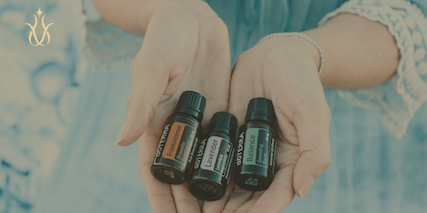
What Are the Must Have Essential Oils?
Several essential oils are considered must-haves due to their versatility and wide range of benefits. Here are some popular essential oils that many people find useful to have in their collection:
Lavender: Lavender oil is well-known for its calming and soothing properties. It promotes relaxation, helps with sleep, and can be used topically for minor skin irritations.
Peppermint: Peppermint oil is invigorating and refreshing. When applied topically, it can help relieve headaches, improve focus and concentration, and provide a cooling sensation.
Tea Tree: Tea tree oil has powerful antimicrobial properties and is commonly used for its skin-cleansing benefits. It can help with acne, minor cuts, and fungal infections.
Eucalyptus: Eucalyptus oil has a refreshing and invigorating aroma. It is often used for respiratory support, helping to clear congestion and promote easy breathing.
Lemon: Lemon oil has a bright and uplifting scent. It is known for its cleansing properties and can be used to freshen the air, boost mood, and support immune health.
Frankincense: Frankincense oil is revered for its calming and grounding properties. It is often used in meditation or for promoting relaxation and emotional balance.
Chamomile: Chamomile oil is soothing and gentle, known for its calming effects. It can be used to promote relaxation, relieve stress, and support healthy skin.
Rosemary: Rosemary oil has a refreshing and stimulating aroma. It can be used for mental clarity, promoting hair growth, and supporting a healthy scalp.
Can You Consume Essential Oils?
While some essential oils are safe for internal use when used in small, diluted amounts and under the guidance of a qualified aromatherapist or healthcare professional, it’s important to note that not all essential oils are safe for ingestion. In fact, many essential oils are toxic and should never be consumed.
Certain essential oils, such as peppermint or lemon, are sometimes used in culinary applications or as flavourings in food and beverages. However, it’s crucial to use food-grade essential oils specifically labelled for internal use and to follow proper dosage guidelines. It’s generally recommended to consult with a qualified professional before ingesting any essential oils, especially if you have any underlying health conditions or are taking medications.
It’s worth noting that essential oils are highly concentrated plant extracts, and their potency can be much stronger than using the whole plant or herb. Ingesting essential oils in large quantities or using them inappropriately can lead to adverse effects and may harm your health. Additionally, certain individuals, such as children, pregnant women, and people with specific medical conditions, should avoid the internal use of essential oils altogether.
Can You Mix Essential Oils?
Yes, you can mix essential oils to create custom blends that suit your preferences or address specific needs. Mixing essential oils allows you to combine their aromas and therapeutic properties to create a unique synergy.
When blending essential oils, it’s important to consider their individual characteristics, such as scent profile, intensity, and therapeutic properties. Here are some tips for safely and effectively mixing essential oils:
Start with a purpose: Determine the purpose or desired effect of the blend. Are you looking for relaxation, focus, or respiratory support? This will guide your selection of essential oils.
Choose complementary oils: Select oils that complement each other in terms of aroma and therapeutic properties. For example, for respiratory support, you can combine lavender and bergamot for a calming blend or eucalyptus and peppermint.
Follow blending ratios: Use proper blending ratios to ensure the safety and effectiveness of your blend. A common guideline is to use a total of 10-20 drops of essential oils per 30 ml (1 oz) of carrier oil or other dilution medium.
Consider top, middle, and base notes: Essential oils are often categorised into top, middle, and base notes based on their evaporation rates. Blending oils from each category can create a balanced and harmonious aroma. For example, combining citrus oils (top note), lavender (middle note), and cedar wood (base note) can create a well-rounded blend.
Perform a patch test: Before applying the blend to a larger area of your skin, apply a small amount to your inner arm. Wait 24 hours to check for any adverse reactions.
Keep track of your recipes: It’s helpful to keep a record of your essential oil blends, including the specific oils used and their respective ratios. This allows you to recreate successful blends in the future.
Where is the Best Place to Get Essential Oils?
The best place to get essential oils depends on your preferences and needs. Here are some options to consider:
Aromatherapy speciality stores: Physical stores specialising in aromatherapy and natural products often carry a wide range of essential oils. These stores usually have knowledgeable staff who can provide guidance and recommendations based on your needs.
Online retailers: Numerous reputable online retailers sell essential oils. Look for well-established and trusted brands or retailers with positive customer reviews. Ensure they provide detailed information about the oils, including sourcing, purity, and any certifications they may have.
Certified aromatherapists: Certified aromatherapists are trained professionals who can offer personalised guidance and may also sell essential oils as part of their practice. They can help you select oils based on your specific needs and provide valuable information on safe and effective usage.
Health food stores: Many health food stores carry a selection of essential oils, often focusing on high-quality and organic options. These stores may also carry other natural products and have knowledgeable staff to assist you.
Farmers’ markets: Some farmers’ markets feature vendors who sell locally sourced and artisanal essential oils. This can be a great way to support local businesses and find unique blends.
When purchasing essential oils, looking for reputable suppliers prioritising quality, purity, and transparency is important. Consider factors such as the sourcing of the plants, extraction methods, and any third-party testing or certifications they may have, such as GC/MS (gas chromatography/mass spectrometry) reports.
Additionally, be cautious of extremely low-priced oils or claims that seem too good to be true. High-quality essential oils require a significant amount of plant material, so prices that are significantly lower than average may indicate inferior quality or adulteration.
What Are the Best Brands of Essential Oils?
Several reputable brands offer high-quality essential oils. Choosing brands prioritising quality, purity, and transparency is important. Here are some well-known and trusted brands that are often recommended:
doTERRA: doTERRA is a popular brand known for its commitment to sourcing pure and potent essential oils. They employ strict quality testing and have a robust network of growers and distillers worldwide.
Young Living: Young Living is another well-established brand that focuses on quality and sustainability. They have their own farms and distilleries and follow a stringent Seed to Seal® process to ensure the purity of their oils.
Plant Therapy: Plant Therapy is a family-owned brand that offers a wide range of affordable, high-quality essential oils. They provide detailed information about their sourcing, testing, and safety practices.
Rocky Mountain Oils: Rocky Mountain Oils (RMO) is known for its high-quality essential oils sourced from around the world. They provide GC/MS test results for each batch of oils, demonstrating their commitment to transparency.
Aura Cacia: Aura Cacia is a well-known brand that offers a diverse selection of essential oils. They prioritise sustainability, quality, and fair trade practices and provide extensive information about their sourcing and testing.
Eden’s Garden: Eden’s Garden offers a wide range of essential oils at affordable prices. They provide GC/MS test reports for each oil and are transparent about their sourcing and quality control practices.
Tisserand Aromatherapy: Tisserand is a well-established UK brand that offers a wide range of essential oils. They prioritise quality, sustainability, and ethical sourcing practices. Tisserand also provides detailed information on the sourcing and extraction methods used for their oils.
Neal’s Yard Remedies: Neal’s Yard Remedies is a UK-based brand that focuses on organic and natural products, including essential oils. They have a selection of pure and certified organic essential oils and offer information about their sourcing and quality standards.
Amphora Aromatics: Amphora Aromatics is a UK-based aromatherapy company that offers a variety of essential oils. They have a good reputation for offering quality oils at affordable prices and providing detailed information about each oil’s origin and properties.
Base Formula: Base Formula is a UK brand specialising in aromatherapy and natural skincare products. They offer a range of essential oils sourced from reputable suppliers and provide guidance on safe and effective use.
Absolute Aromas: Absolute Aromas is a UK-based company that provides a wide range of essential oils. They emphasise the importance of quality and purity and offer detailed information on their sourcing, testing, and safety practices.
It’s important to note that individual preferences may vary, and what works for one person may not work the same for another.
It’s recommended to do your own research, read customer reviews, and consider factors such as sourcing practices, transparency, and customer satisfaction when choosing a brand.
Remember, high-quality essential oils should be pure and free from additives or synthetic ingredients. Look for brands that provide information about their sourcing, testing methods, and any certifications they may have. Additionally, consider consulting with a certified aromatherapist or knowledgeable practitioner who can provide personalised recommendations based on your specific needs.
Resources:
Essential Oils as Multicomponent Mixtures and Their Potential for Human Health and Well-Being.
Bunse M, Daniels R, Gründemann C, et al.
Frontiers in Pharmacology. 2022;13:956541.
Vora LK, Gholap AD, Hatvate NT, et al.
Journal of Ethnopharmacology. 2024;330:118180.
Ishfaq PM, Shukla A, Beraiya S, Tripathi S, Mishra SK.
Anti-Cancer Agents in Medicinal Chemistry. 2018;18(13):1815-1827.
Solórzano-Santos F, Miranda-Novales MG.
Current Opinion in Biotechnology. 2012;23(2):136-41.
Edris AE.
Phytotherapy Research : PTR. 2007;21(4):308-23.
Ramsey JT et al (2020). Essential Oils and Health. Available at: https://pubmed.ncbi.nlm.nih.gov/32607090/
Vaughn AR et al (2028). Natural Oils for Skin-Barrier Repair: Ancient Compounds Now Backed by Modern Science. Available at: https://link.springer.com/article/10.1007/s40257-017-0301-1
Mayo Clinic – Home Remedies: What are the benefits of aromatherapy? Available at: https://www.mayoclinic.org/healthy-lifestyle/consumer-health/expert-answers/aromatherapy/faq-20058566
Medical News Today – Aromatherapy: What you need to know. Available at: https://www.medicalnewstoday.com/articles/10884
Disclaimer: This article is for informational purposes only and should not replace professional medical advice. If you have specific concerns or medical conditions, it is recommended to consult with a healthcare professional for personalised guidance and support.
Related Topics:
The Top Natural Anti-Aging Remedies
Top 10 Health Spas for Ultimate Wellness
